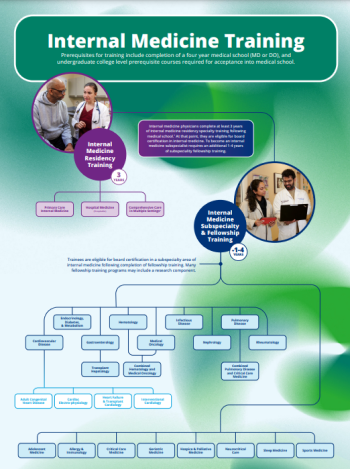All internal medicine physicians share a basic core of training that forms the foundation for whichever discipline within internal medicine they choose to pursue.

training with this easy-to-follow infographic.
Basic training in internal medicine is three years of residency (termed 'categorical' training) following medical school. Following completion of three years of training, residents are eligible for board certification in internal medicine. About half of the country’s internal medicine residents choose to practice General Internal Medicine. General internal medicine physicians are capable of functioning in a number of different roles. For example, many focus on ambulatory practice and may serve as primary care physicians, following patients longitudinally for their ongoing medical care. Others may spend a majority of their time caring for hospitalized patients in the role of hospitalist (over 90% of hospitalists are general internal medicine physicians). However, many general internal medicine physicians care for both ambulatory and hospitalized patients in a very wide variety of practice models.
Others choose to pursue additional training beyond the basic three years of residency training, subspecializing in a particular area of interest within internal medicine. Some of the specific subspecialties of internal medicine and their associated area of interest include:
- Cardiology – the heart and vascular system
- Endocrinology – the glandular and hormonal systems
- Gastroenterology – the digestive system, including the liver and metabolism/nutrition
- Hematology – disorders of the blood, bone marrow, and lymphatics
- Oncology – benign and malignant neoplastic diseases
- Infectious Diseases – the broad spectrum of infectious agents, their clinical manifestation of disease and treatment
- Nephrology – the kidney and associated diseases
- Pulmonary & Critical Care – the respiratory system and management of extremely ill patients
- Rheumatology – the musculoskeletal system, particularly related to systemic and metabolic disorders
Additional subspecialties in internal medicine that are also available to those who have completed training in another specialty include:
- Adolescent Medicine - care of adolescents and young adults
- Allergy and Immunology - the immune system
- Critical Care Medicine - care of patients in intensive care settings
- Geriatric Medicine - care of older patients
- Hospice and Palliative Medicine - care of patients with serious illness
- Neurocritical Care - serious diseases of the nervous system
- Sleep Medicine - sleep disturbances and disorders
- Sports Medicine - sports and exercise
Internal medicine training may also be combined with training in another specialty, leading to board certification in both fields. These dual training programs are generally structured to be shorter than the time it would take to complete an independent residency in both fields, and graduates of these programs are particularly qualified to care for patients in both areas of focus. Examples include internal medicine and pediatrics, emergency medicine, and psychiatry.
Learn more about the unique leadership roles, career pathways and impact of internal medicine physicians. Learn more

